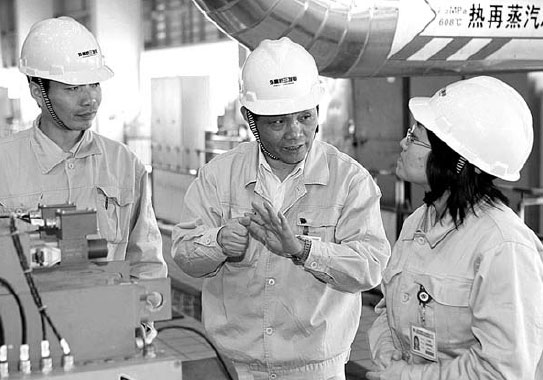Innovator's persistence pays off at coal plant
Updated: 2015-07-20 07:54
By Wang Ying in Shanghai(China Daily)
|
|||||||||||
In the past seven years, Feng Weizhong has managed to save more than 1 million metric tons of standard coal for a Shanghai power company.
Feng's persistent research and innovation in energy saving, emissions reduction and safety-insurance technology in the power industry have paid dividends for the Shanghai Waigaoqiao No 3 Power Generation Co Ltd.
His efforts saw the company reach a peak of 46.5 percent net efficiency, with his innovations saving more than 1 million tons of standard coal from 2008 to 2013.
|
Feng Weizhong (middle) talks to colleagues during an on-site inspection at the Shanghai Waigaoqiao No 3 Power Generation Co Ltd. Provided to China Daily |
Feng, general manager of the power plant, was born in 1954. Although he received only five years' formal education at primary school, he finally became a senior engineer after decades of self-study.
"My studies had to stop during the 'cultural revolution' (1966-76), but I never stopped working. Thanks to my father, who believed the country's chaotic situation would be only temporary, I knew the importance of knowledge would be recognized again sooner or later."
In 1971, Feng started work as an apprentice at a coal-fired plant at Chongming Island, Shanghai.
After decades of continuous self-study, he stood out from other workers and became general manager of the newly built two 1,000-megawatt coal-fired power generating units at the Shanghai company.
The Waigaoqiao power plants supply about a quarter of Shanghai's power consumption needs, but coal power, regarded as "dirty energy", has been blamed for increasingly serious pollution in China.
To solve the problem, for the past seven years Feng has tried many times to cut emissions at the lowest cost and by using the best way to save energy.
Based on Siemens AG generator technology and Alstom SA boiler technology, construction at Waigaoqiao cost 8.5 billion yuan ($1.37 billion).
The company's annual average unit net coal consumption rate is 276 grams per kilowatt-hour.
Unit net coal consumption measures the energy efficiency of a coal-fired power plant. The national average in 2013 was 321 grams per kWh, and Waigaoqiao's was more than 10 grams per kWh lower than that of a well-recognized advanced facility in Denmark.
At the same time, Waigaoqiao's emissions have set down a marker for the world.
It had average-level dust emissions of 0.74 micrograms per cubic meter and sulfur dioxide emissions of 14.94 micrograms per cubic meter, less than one-third the maximum allowed under the latest regulation governing emissions.
Despite increased calls for more use of clean energy, coal is still the leading source used to produce electricity in most countries, said Mao Jianxiong, a Tsinghua University professor, quoted by China Electric Power News.
"For example, coal-fired power plants are still the No 1 power contributor in the United States, and up to 90 percent of the power in Australia is derived from coal. In China, more than 70 percent of power comes from burning coal," Mao said.
Feng said that after years of innovation and research, he can prove that a coal-fired plant could be even cleaner than a gas-fired power station.
However, he has bigger goals to achieve, such as lowering unit net coal consumption to 251 gram per kWh and to increase the efficiency rate to 48.92 percent.
Feng has more than 40 patents in China, the US and the European Union, and the 60-member team that he heads is working to make breakthroughs in next-generation technology.
Li Li, one of the research team members, said he once asked Feng why he looked for new developments each day after achieving so many goals and winning so many patent rights.
"'The answer is the responsibility for history and for the industry's development,' Feng told me."
wang_ying@chinadaily.com.cn
(China Daily 07/20/2015 page5)
Today's Top News
China, World Bank pledge $50m for poor
Web companies asked to support 'digital Silk Road': Zhanjiang forum
Risks growing for cybersecurity
China's stock wobbles may deter foreign investors - for now
Europe moves to restore funding to Greece after bailout vote
Low fertility rate hampers NE China's development
Industries should be on digital Silk Road
'Occupy Central' leaders to stand trial
Hot Topics
Lunar probe , China growth forecasts, Emission rules get tougher, China seen through 'colored lens', International board,
Editor's Picks

|

|

|

|

|

|







